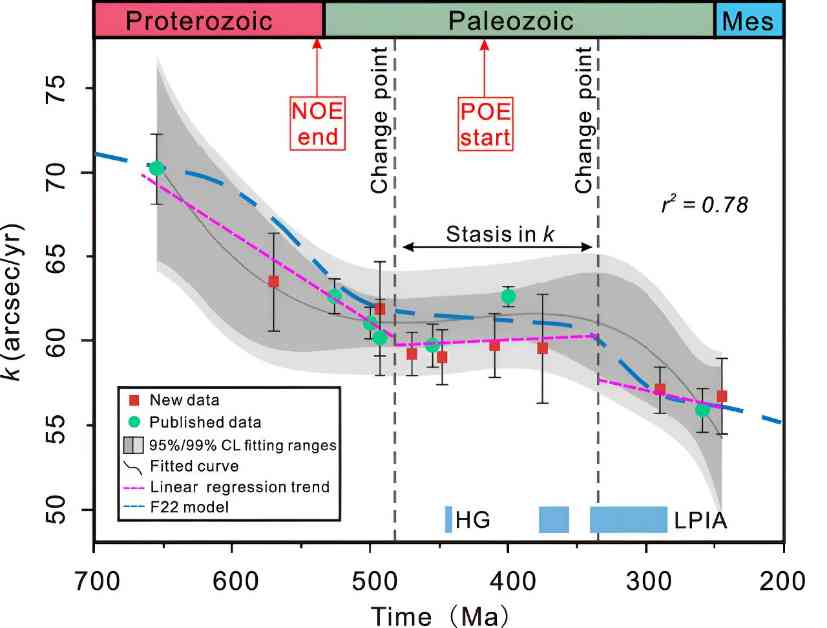Earth’s Rotation History: Deceleration in Staircase Pattern
A recent study published in the Proceedings of the National Academy of Sciences has shed new light on Earth’s rotation history, revealing a fascinating staircase pattern in its deceleration. Conducted by a multi-institutional team of geoscientists, the research analyzed sediment sample data spanning over half a billion years to uncover the trends in Earth’s axial spin.
Previous studies have indicated that Earth’s rotation is slowing down primarily due to tidal dissipation. However, the rate of deceleration has not been consistently documented. In this latest effort, researchers delved into geological datasets dating back 650 million years to track the changes in Earth’s rotational speed.
The team examined eight different sedimentary archives that provided insights not only into the planet’s geological past but also its rotational history. These datasets covered a timeframe from 280 to 650 million years ago, revealing a non-linear pattern of deceleration characterized by periods of slowdown followed by stability.
Interestingly, the researchers identified two distinct stable periods amidst the deceleration phases. One coincided with the Cambrian explosion, a pivotal time in Earth’s history marked by a significant increase in biodiversity. The other stable period aligned with the largest known mass extinction event, hinting at a potential correlation between Earth’s rotation and major environmental changes.
The data also confirmed that aside from recent disruptions caused by human activities, such as climate change, the deceleration of Earth’s rotation has been primarily driven by tidal dissipation. This process involves the conversion of orbital and rotational energy into heat within the surface ocean, the planet’s interior, or the moon. Tidal heating occurs as the moon exerts gravitational forces on Earth, causing it to stretch and compress.
Moreover, the research team observed that over the studied period, the moon has gradually moved approximately 20,000 kilometers farther away from Earth, leading to an increase in Earth’s day length by about 2.2 hours. This finding underscores the dynamic relationship between Earth, the moon, and the changes in rotational speed over geological timescales.
Looking ahead, the researchers plan to further investigate the links between Earth’s rotation variations and significant environmental events. By unraveling the complexities of our planet’s rotational history, they aim to deepen our understanding of the intricate mechanisms driving Earth’s dynamic systems.
In conclusion, the study’s findings offer valuable insights into Earth’s rotation patterns and their implications for the planet’s geological and environmental evolution. By uncovering the staircase-like deceleration trend and identifying key stable periods, the research opens up new avenues for exploring the interconnected processes shaping Earth’s past, present, and future.
Implications for Climate and Geology
The study’s revelations about Earth’s rotation history and its deceleration in a staircase pattern have significant implications for climate and geology. The findings suggest that changes in Earth’s rotational speed may have played a role in shaping past environmental conditions, including biodiversity shifts and mass extinction events.
Understanding the mechanisms behind Earth’s rotation variations can provide valuable insights into how our planet’s climate and geological processes have evolved over millions of years. By tracing the intricate patterns of deceleration and stability, researchers can uncover the complex interplay between Earth’s rotation, the moon’s orbit, and environmental changes.
Moreover, the study’s focus on tidal dissipation as a key driver of Earth’s deceleration highlights the importance of gravitational forces in shaping our planet’s dynamics. The conversion of orbital and rotational energy into heat through tidal heating offers a glimpse into the fundamental processes that govern Earth’s rotation and its relationship with the moon.
By delving into Earth’s rotational history, scientists can gain a deeper appreciation for the interconnected nature of our planet’s systems. From biodiversity shifts to mass extinctions, the study underscores the profound impact of Earth’s rotation variations on the evolution of life and the environment.
Future Research Directions
As researchers continue to unravel the mysteries of Earth’s rotation history, several key questions remain unanswered. The study’s identification of stable periods amidst the deceleration phases raises intriguing possibilities for further investigation.
Future research could explore the underlying causes of these stable periods and their potential links to major environmental events. By examining the factors that contribute to Earth’s rotational variations, scientists can enhance our understanding of the complex interactions driving the planet’s geological and climatic evolution.
Moreover, ongoing studies on Earth’s rotation patterns could shed light on the long-term consequences of human-induced disruptions to the global environment. By comparing past deceleration trends to current changes in Earth’s rotation speed, researchers can assess the impacts of human activities on the planet’s dynamic systems.
Overall, the study’s findings pave the way for future research endeavors aimed at uncovering the intricacies of Earth’s rotational dynamics. By exploring the staircase-like pattern of deceleration and stability, scientists can gain valuable insights into the forces shaping our planet’s history and shaping its future.













